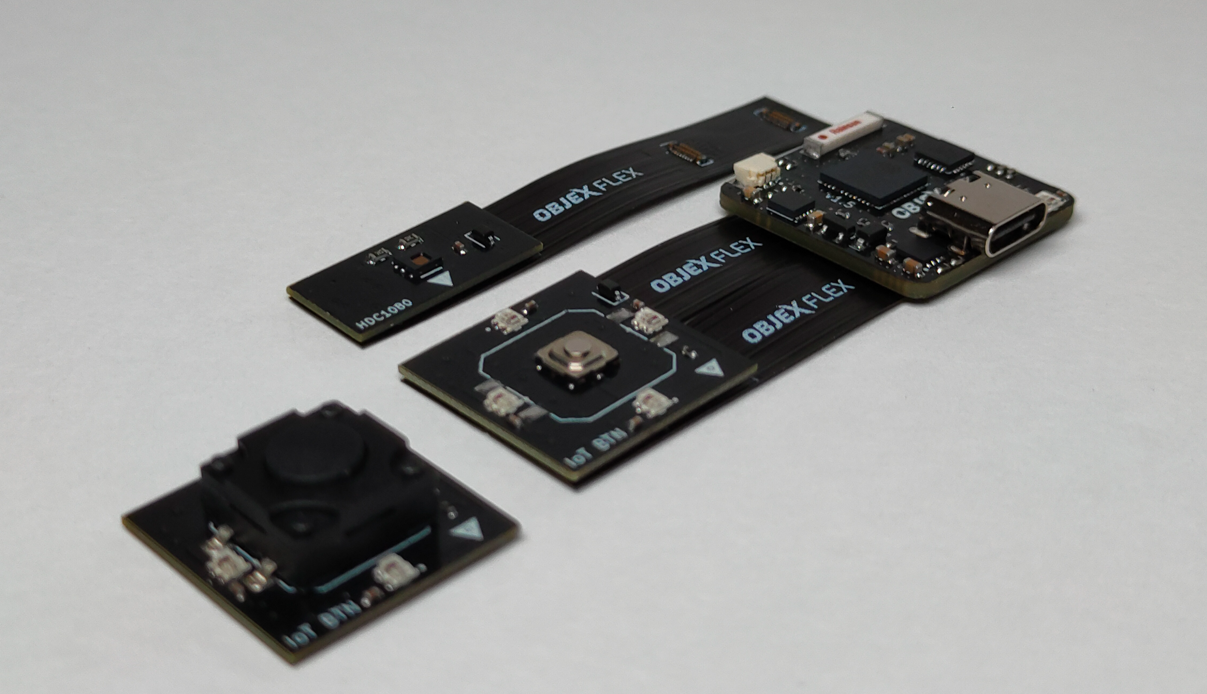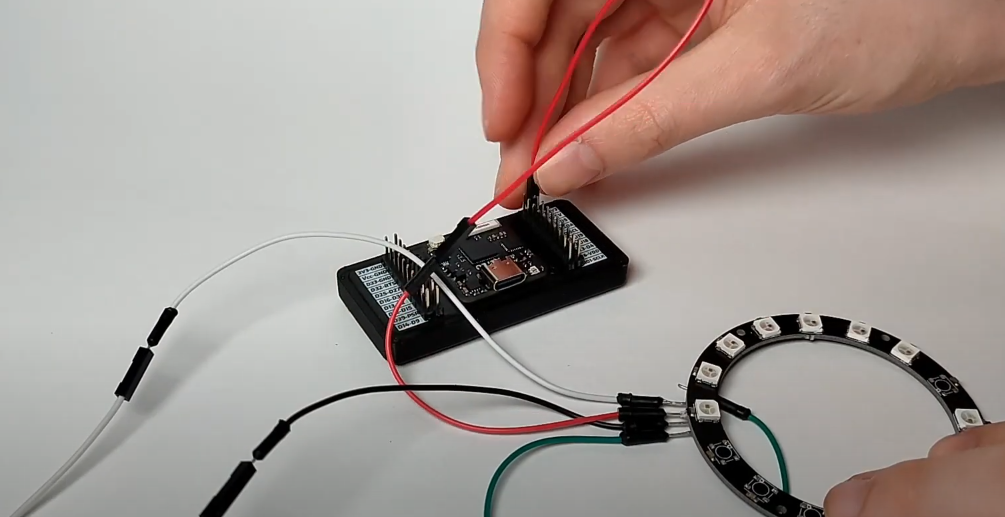OBJEX Link is a modular IoT board based on ESP32. It is designed to develop IoT devices, which are easy to repair and reusable.
Designed by OBJEX in ItalyNo shipping info available.
Set destination country to see options
Shipping to starts at
Free shipping is available to !
Ships from
This item does not ship to .
More Info
Sign up to get notified when this product is back in stock!
OBJEX Link is the world’s smallest modular IoT board, is designed for hobbyists, makers, designers, students and can also be used in industrial applications. It is designed to develop IoT devices, wh…
Read More…OBJEX Link is the world’s smallest modular IoT board, is designed for hobbyists, makers, designers, students and can also be used in industrial applications. It is designed to develop IoT devices, which are easy to repair and reusable at the end of the device life cycle.
The form factor of OBJEX Link is meant to fit several applications like(IoT button, security camera, motor driver, etc). With modules, the user can customize easily the hardware for your projects.
OBJEX Link is composed of a mainboard(microcontroller + WiFi and Bluetooth) and modules(Sensor, Relay, Driver, Camera, Display, etc).
OBJEX Link v1.0 and v1.5 are based on ESP32-PICO-D4 microcontroller, to program the board you can use Arduino IDE or other similar solutions - OBJEX Link rev1.5 does not support MicroPython.

The possible uses of OBJEX Link are endless, you can potentially use OBJEX Link for any device with the right module. If you need very compact and reliable hardware for your IoT devices, OBJEX Link is the best choice.

OBJEX Link has one goal, to make the hardware in IoT devices easy to reuse. Connecting devices is very important and exciting to build the society of the future but protect the environment is even more important.
There are other solutions on the market, but few of them are designed to actually reuse the hardware. Many devices have custom hardware/PCBs so it makes it impossible to recycle it for other devices.
For more information on the project see the Wiki.

No. The main differences between OBJEX Link and other boards on the market are:
Purpose: Develop reusable hardware for heterogeneous internet-connected objects, that are easy to install, repair, and recycle.
Modularity: Hardware designed for different applications, easy to recycle at the end of the device life cycle.
Design: Compact, lightweight, and suitable for use in several applications.
OBJEX Link can also be used for simple prototyping as is commonly done with other boards on the market.

Compatible modules
Hardware
Modules are an essential element of OBJEX Link. They are the modules that allow OBJEX Link to detect temperature, control a motor, etc - (like Arduino shields but smaller and more compact).

Types of modules
There are currently two module formats to ensure maximum customization.
| Type | Description | Size | PCB thickness | Connector | Connector Type | 3V3 | 5V | A |
|---|---|---|---|---|---|---|---|---|
| M0 | Standard Module | 10x20mm | 0.8mm | 2 | BM28B0 | ✓ | ✓ | 5 |
| M1 | Standard Module | 20x20mm | 0.8mm | 4 | BM28B0 | ✓ | ✓ | 5 |
All modules are open source, so any user can develop their own module. If you want to develop your first module click here to download the connector library.
The applications of OBJEX Link are so many, but obviously, they are limited by the number of modules available. If you need very compact and reliable hardware for your IoT devices, OBJEX Link is the best choice.
The modules are connected with OBJEX Link through four low-profile SlimStack connectors. These low-profile connectors allow for maximum board compactness, in this way, you can use OBJEX Link for tiny devices.

Slimstack connectors are not easy to be soldered, and you need specific equipment to do so. If you want to use OBJEX Link in your project without soldering the SlimStack connectors, you can use a custom socket (you can buy it).

You can implement OBJEX Link easily in your projects, you just need to Download the socket footprint.

If you've ever opened a smartphone or any smart device you've surely noticed the presence of flexible PCBs to connect PCBs or circuit elements. With these flexible PCBs, it is possible to make the design of the device as compact as possible.

Flexible cables give you the opportunity to make the modules versatile and most importantly to fit the type of design or the final application of the designed device.

As mentioned in the initial description of OBJEX Link, this product is not intended for making very simple prototypes. But using a simple module "ProtoBoard" it is possible to develop prototypes quickly.

With two or more ProtoBoards you can make several prototypes at the same time with only one OBJEX Link. This way you do not have to disconnect and reconnect any cables. You only have to unplug OBJEX Link from the protoboard and plug it in another prototype you are working on and if you need to load new firmware.

Example 1: Weather station
With OBJEX Link you can develop a very compact and precise weather station, in this first picture(config 1) you see, the HDC1080 module is connected directly to OBJEX Link. This configuration is certainly useful because it is very compact and thin, but the detected temperature and humidity will be affected by overheating of the components on OBJEX Link.
The problem of overheating is present in many boards on the market, in fact very often the temperature sensors are placed very close to circuit elements that get hot and that compromise the temperature measurement.

The second configuration solves the problem related to board overheating. In this way the detected temperature is reliable.
This is possible by using OBJEX Flex which allows the module to be moved away from OBJEX Link through a simple extension of the SlimStack connector connections. So in this example, it allows the module to be thermally isolated from OBJEX Link. In addition, you can move the module freely, taking great care not to bend OBJEX Flex too much.


Example 2: IoT button
With OBJEX Link you can also develop a simple IoT button, again you can decide whether to install the button directly on the OBJEX Link PCB(Config 1).

Or you can also use two flexible cables (Config 2), this way you can move the button module to a different position.

More modules will be developed in the future, to enable users to use OBJEX Link over time.
No country selected, please select your country to see shipping options.
No rates are available for shipping to .
Enter your email address if you'd like to be notified when OBJEX Link rev1.5 can be shipped to you:
Thanks! We'll let you know when the seller adds shipping rates for your country.
| Shipping Rate | Tracked | Ships From | First Item | Additional Items |
|---|---|---|---|---|
|
:
|
Usually shipped within 3-7 working days. For more information: info@objexlabs.com
No shipping info available.
Set destination country to see options
Shipping to starts at
Free shipping is available to !
Ships from
This item does not ship to .
More Info
Sign up to get notified when this product is back in stock!
By clicking Register, you confirm that you accept our Terms & Conditions
We recognize our top users by making them a Tindarian. Tindarians have access to secret & unreleased features.
We look for the most active & best members of the Tindie community, and invite them to join. There isn't a selection process or form to fill out. The only way to become a Tindarian is by being a nice & active member of the Tindie community!
